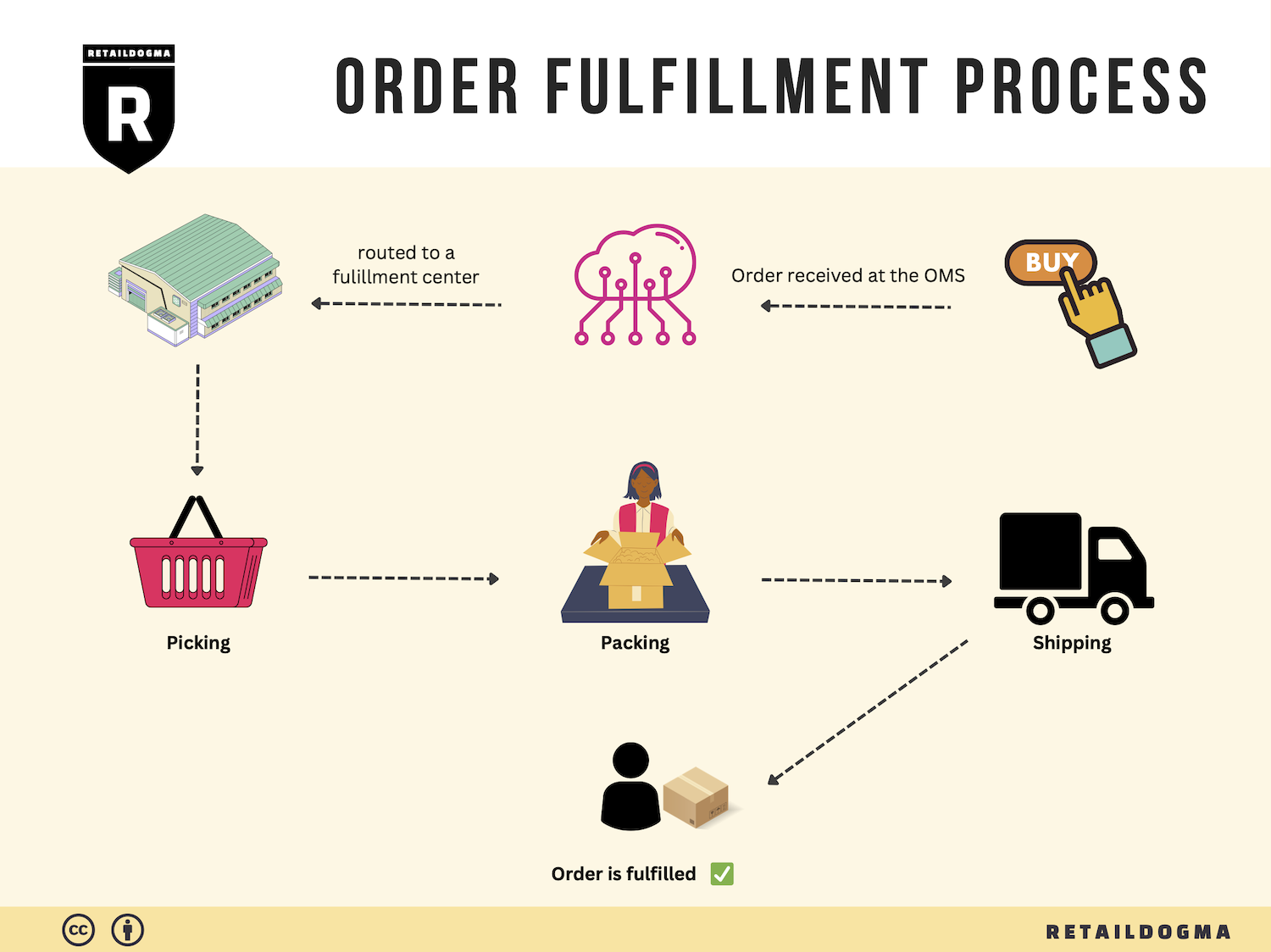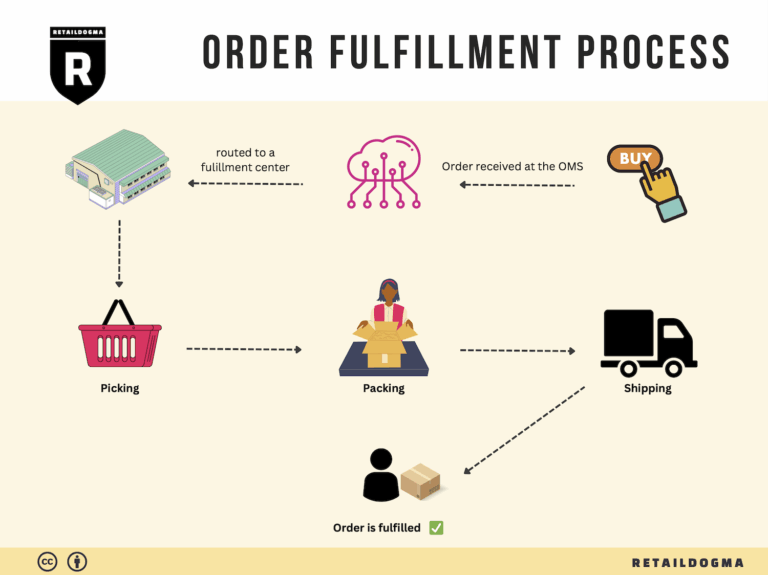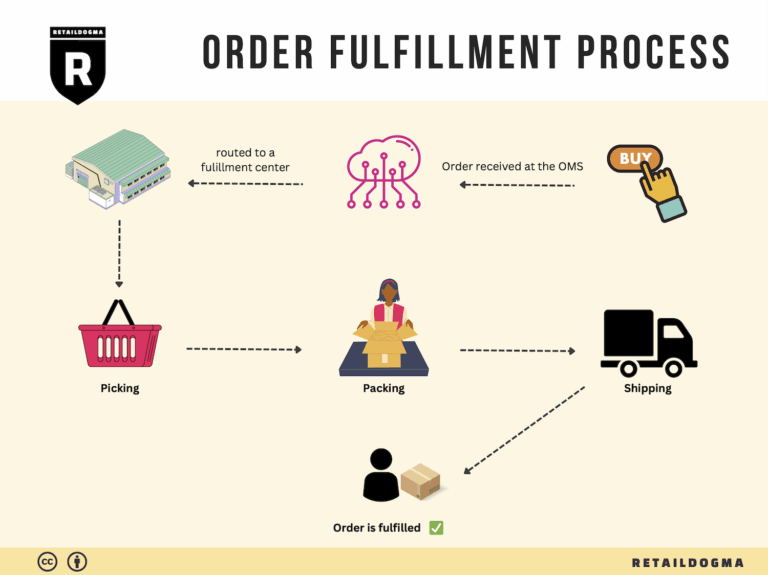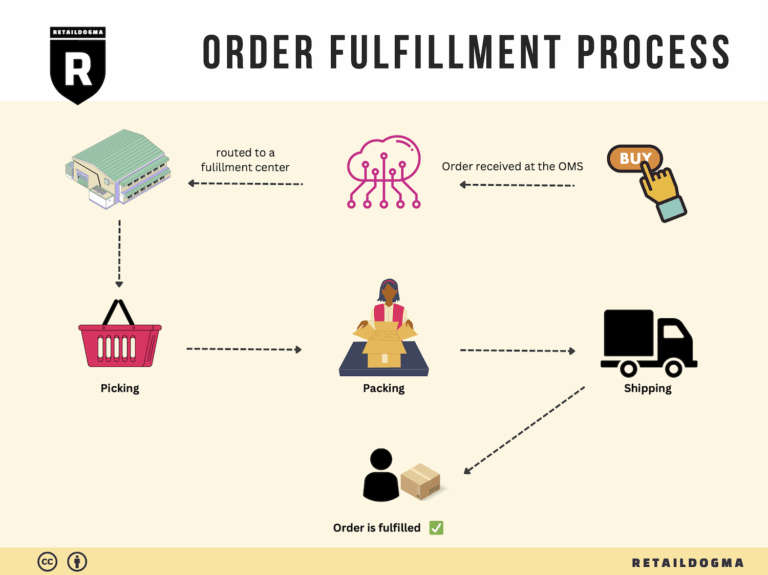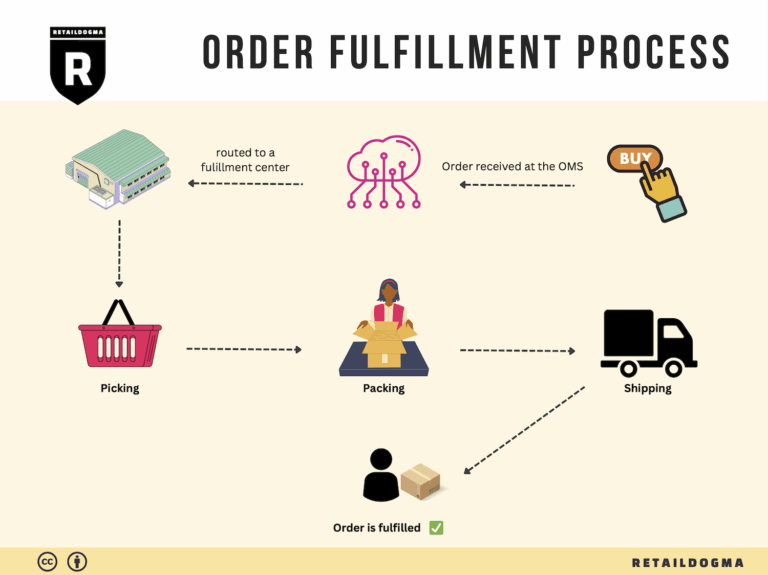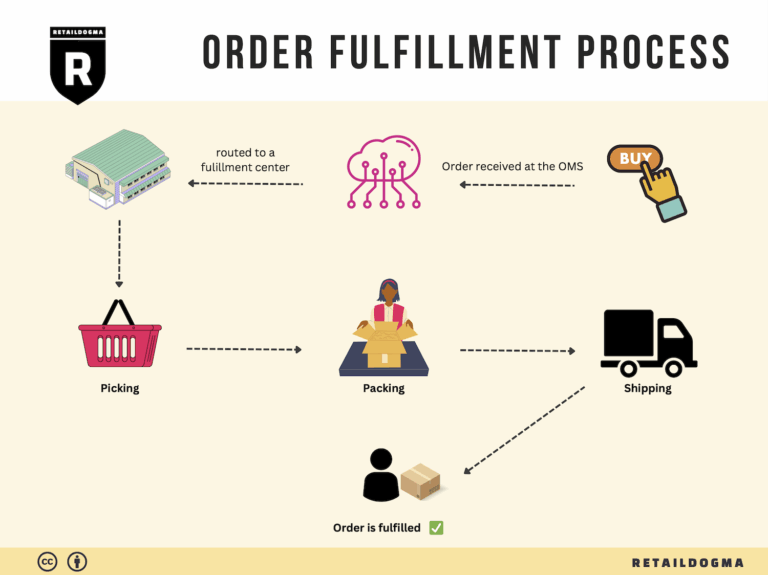What Is A Fulfillment Center? A Complete Guide (2025)
What is E-commerce Fulfillment? An Introduction for Growing Businesses
Understanding E-commerce Fulfillment: A Pathway to Streamlined Operations
As an e-commerce business owner, you may find yourself grappling with the complexities of packing and shipping orders. The excitement of growing sales can quickly turn into a logistical nightmare if you are not prepared to handle the increasing volume of orders. This is where e-commerce fulfillment comes into play. Simply put, fulfillment is the process of getting a product from your inventory to the customer’s doorstep. It encompasses everything from receiving inventory, storing products, picking and packing orders, to shipping them out.
In this guide, we will explore the various facets of e-commerce fulfillment, providing you with the insights needed to make informed decisions for your business. We’ll delve into different fulfillment models, including Third-Party Logistics (3PL) and Fulfillment by Amazon (FBA), helping you understand the advantages and disadvantages of each. Choosing the right model can significantly impact your operational efficiency and customer satisfaction.
We will also cover the core services involved in e-commerce fulfillment. These services typically include inventory management, order processing, packaging, shipping, and returns management. Understanding these components is crucial for ensuring that your customers receive their orders in a timely and satisfactory manner.
Selecting the right fulfillment partner is a pivotal decision for any growing business. In this guide, we will outline the key factors to consider when evaluating potential partners, such as their technology capabilities, shipping options, pricing structures, and customer service. A well-chosen partner can not only streamline your logistics but also enhance your overall customer experience.
Finally, we will address pricing models related to fulfillment services. Understanding how fulfillment partners charge for their services—be it through per-order fees, storage fees, or shipping costs—will enable you to budget effectively and maintain healthy profit margins.
The ultimate goal of this guide is to empower you to make smart, strategic decisions about your logistics operations. By gaining a clearer understanding of e-commerce fulfillment, you can focus on scaling your business while ensuring that your customers receive the best possible service. Whether you’re just starting out or looking to optimize an existing operation, this guide will provide the practical knowledge you need to navigate the complexities of e-commerce fulfillment successfully.
What You’ll Learn In This Guide
- What is E-commerce Fulfillment? An Introduction for Growing Businesses
- The Order Fulfillment Process: From ‘Buy’ Button to Customer’s Door
- Comparing Fulfillment Models: In-House vs. 3PL vs. Dropshipping
- A Deep Dive into Amazon FBA: Pros, Cons, and Who It’s For
- Core Services Offered by Fulfillment Centers
- How to Choose a Fulfillment Partner: A 6-Point Checklist
- Understanding Fulfillment Pricing: A Breakdown of Common Fees
- Frequently Asked Questions (FAQs) about Fulfillment
- Conclusion: Is Outsourcing Fulfillment the Right Move for Your Business?
- Important Disclaimer
The Order Fulfillment Process: From ‘Buy’ Button to Customer’s Door
1. Receiving Inventory
The first step in the order fulfillment process is receiving inventory. When products arrive at the fulfillment center, they undergo a thorough check-in process to ensure that the correct items and quantities have been delivered. This involves scanning barcodes or QR codes to match the incoming products against purchase orders, a process often facilitated by a system known as SKU (Stock Keeping Unit).
Importance: This step is crucial because it lays the foundation for accurate inventory management. Any discrepancies at this stage can lead to stockouts or excess inventory, which can severely disrupt future operations.
Key Term: SKU (Stock Keeping Unit) – a unique identifier assigned to each product that allows for efficient tracking and management of inventory.
2. Warehouse Storage
Once the inventory has been received and verified, the next step is warehouse storage. Products are then stowed in designated locations within the fulfillment center. Modern warehouses often utilize advanced storage systems that optimize space and enhance accessibility, such as automated shelving and robotic storage systems, like Kiva robots utilized by Amazon.
Importance: Proper storage is essential for efficient order fulfillment. It reduces the time needed to locate products when an order is placed and minimizes the risk of damage or loss. An effective storage strategy also improves the overall workflow of the fulfillment center.
Key Term: ABC Analysis – a method of categorizing inventory based on importance, where ‘A’ items are high-value and low-quantity, ‘B’ items are moderate in both, and ‘C’ items are low-value and high-quantity.
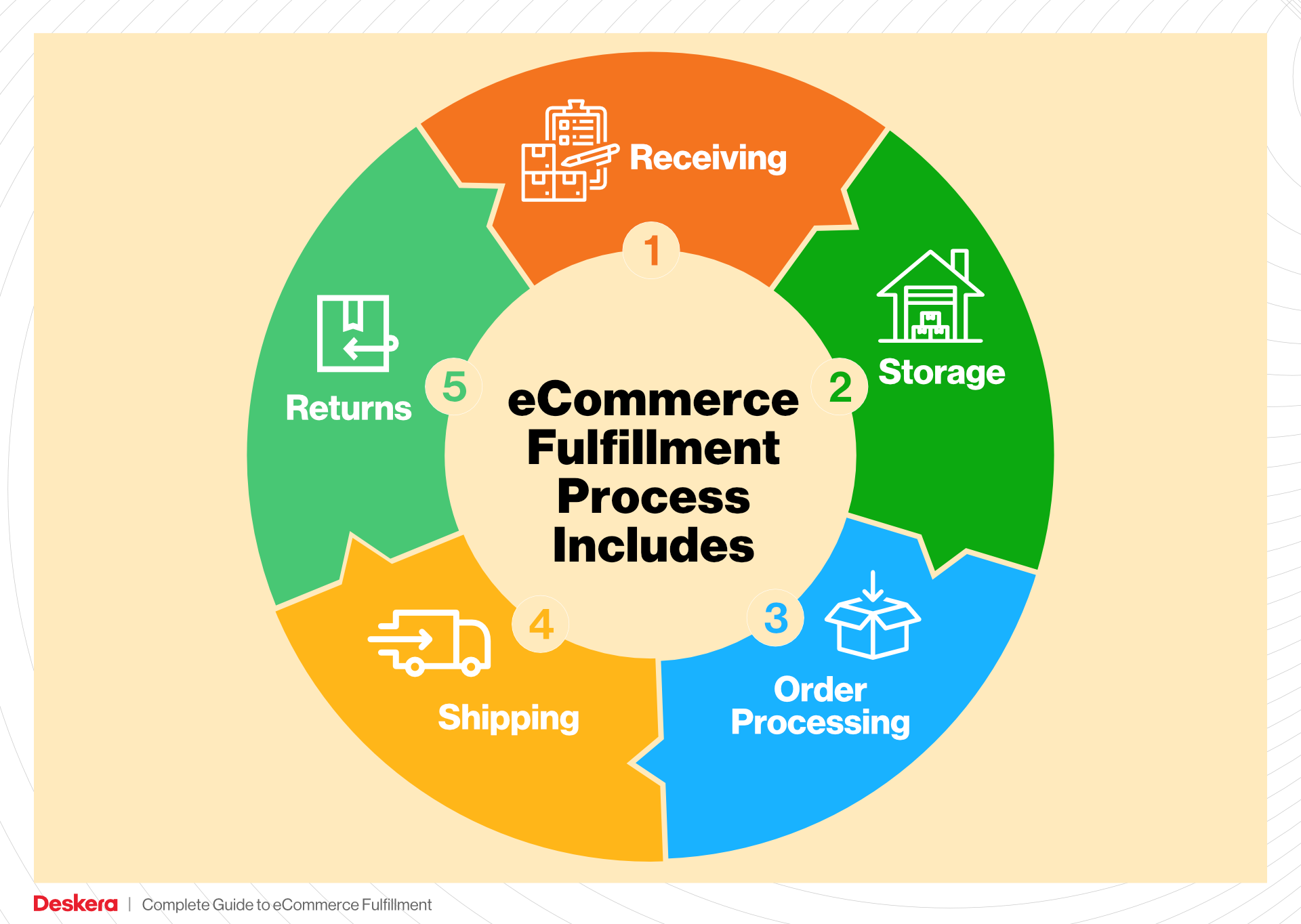
3. Order Picking
The third step is order picking, where employees or robots retrieve items from the warehouse to fulfill customer orders. Order picking can be done using different methods, such as single order picking (one order at a time) or batch picking (multiple orders at once). Pick lists, which outline the items needed for each order, are generated to streamline this process.
Importance: This step is vital because it directly impacts the accuracy and speed of order fulfillment. Efficient picking reduces lead times, ensuring that customers receive their products quickly and correctly, which is crucial for maintaining customer satisfaction and loyalty.
Key Term: Pick List – a document or digital tool that outlines the items to be collected for a particular order, often prioritized to facilitate efficient retrieval.
4. Order Packing
After the items are picked, they move on to the packing stage. Here, products are carefully packed into boxes or other shipping containers, ensuring that they are protected during transit. This involves selecting appropriate packaging materials, labeling, and sometimes including promotional materials or return instructions.
Importance: Effective packing not only protects the products but also enhances the customer experience. Well-packed orders can reduce the likelihood of returns due to damage, and professional packaging can reflect positively on the brand. Additionally, accurate labeling ensures that packages reach the correct destinations without delays.
Key Term: Packing Slip – a document included in the package that lists the contents of the order, providing transparency and aiding in the returns process if necessary.
5. Shipping & Delivery
The final step in the order fulfillment process is shipping and delivery. Once orders are packed, they are handed over to logistics providers for distribution. This step can involve various shipping methods, including ground, air, or local delivery services, depending on customer preferences and delivery timelines.
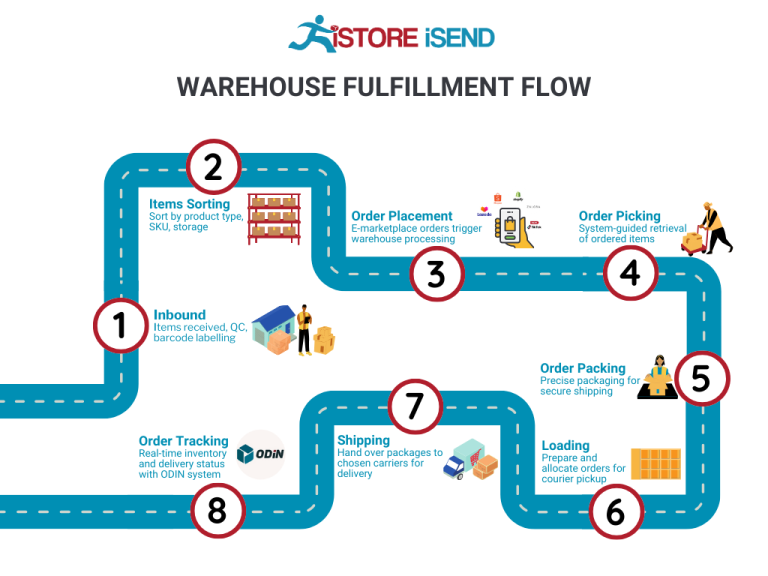
Importance: This stage is critical as it represents the last point of contact with the customer before they receive their order. Timely and reliable shipping can significantly affect customer satisfaction and influence future purchasing decisions. Additionally, tracking systems allow customers to monitor their orders in real-time, enhancing transparency.
Key Term: Last-Mile Delivery – the final step of the delivery process, where the package is transported from a distribution center to the customer’s doorstep, often seen as the most crucial and challenging part of the shipping process.
Understanding each of these steps in the order fulfillment process is essential for e-commerce business owners and operations managers looking to scale their logistics. By optimizing each phase, businesses can enhance efficiency, reduce costs, and ultimately improve customer satisfaction.
Comparing Fulfillment Models: In-House vs. 3PL vs. Dropshipping
Fulfillment Model Comparison
| Model | Who Handles Inventory | Best For (Business Stage) | Key Advantage | Key Disadvantage |
|---|---|---|---|---|
| In-House Fulfillment | Business Owns Inventory | Established Businesses | Complete control over inventory | High overhead costs |
| Third-Party Logistics (3PL) | 3PL Provider | Scaling Businesses | Scalability and flexibility | Less control over inventory |
| Dropshipping | Supplier | Startups and Small Firms | Low upfront costs | Lower profit margins |
In-House Fulfillment
In-house fulfillment involves managing the entire warehousing and shipping process within your own facilities. Businesses that choose this model typically own their inventory and directly control the logistics, including picking, packing, and shipping orders. This model is best suited for established businesses with a stable order volume, as it requires significant investment in warehouse space, inventory management systems, and staffing. The primary advantage of in-house fulfillment is the complete control it provides over inventory management, allowing businesses to implement tailored processes and maintain quality assurance. However, this model also comes with significant overhead costs, including rent, utilities, labor, and equipment, which can strain cash flow, especially for smaller businesses.
Third-Party Logistics (3PL)
Third-party logistics (3PL) is a model where businesses outsource their warehousing and fulfillment processes to specialized logistics providers. This arrangement allows companies to leverage the expertise and infrastructure of the 3PL provider, which handles inventory management, order fulfillment, and shipping. 3PL is particularly advantageous for businesses looking to scale quickly without the burden of managing logistics in-house. The scalability and flexibility of 3PL services mean that businesses can easily adjust their fulfillment needs based on seasonal demand or market fluctuations. However, the main drawback of utilizing a 3PL provider is the reduced control over inventory and fulfillment processes. Businesses may face challenges in ensuring that the quality of service aligns with their brand standards, which can impact customer satisfaction.
Dropshipping
Dropshipping is a fulfillment model where the retailer does not keep products in stock. Instead, when a retailer sells a product, they purchase the item from a third party—usually a wholesaler or manufacturer—who then ships it directly to the customer. This model is particularly popular among startups and small businesses because it requires minimal upfront investment in inventory. Retailers can offer a wide range of products without the financial risk associated with unsold stock. The key advantage of dropshipping is the low upfront costs and reduced risk, allowing entrepreneurs to test new products without significant investment. However, the downside is that dropshipping often results in lower profit margins compared to other models, and retailers have limited control over inventory and shipping times, which can lead to customer dissatisfaction if not managed carefully.
Conclusion
Selecting the right fulfillment model is crucial for e-commerce businesses looking to scale efficiently. In-house fulfillment offers control but at a higher cost, making it suitable for established companies. 3PL provides flexibility and scalability but may compromise control over the customer experience. Dropshipping is ideal for startups seeking low-risk entry into the market, but it comes with its own set of challenges regarding profitability and service quality. Business owners must weigh these factors carefully based on their specific needs, growth trajectory, and market dynamics to choose the most effective fulfillment strategy.
A Deep Dive into Amazon FBA: Pros, Cons, and Who It’s For
Understanding Fulfillment by Amazon (FBA)
Fulfillment by Amazon (FBA) is a service that allows sellers to store their products in Amazon’s fulfillment centers. In turn, Amazon takes care of storage, packaging, and shipping of products to customers. This service has revolutionized the way e-commerce businesses operate, offering a seamless experience for sellers and consumers alike.
When a customer orders a product that is fulfilled by Amazon, the process begins with the product being picked from the warehouse by Amazon staff or robots. It is then packed into a box, labeled, and shipped directly to the customer. FBA also provides customer service and handles returns, making it an attractive option for sellers looking to scale their businesses without the complexities of logistics.
How FBA Works
-
Product Preparation: Sellers prepare their products according to Amazon’s guidelines, which include labeling and packaging requirements.
-
Shipping to Amazon: Once the products are ready, sellers ship them to Amazon’s designated fulfillment centers. Amazon will provide specific instructions on where to send each product.
-
Storage: Products are stored in Amazon’s warehouses until they are sold. Sellers can monitor their inventory levels through their Amazon Seller Central account.
-
Order Fulfillment: When a customer places an order, Amazon takes over. The order is processed, and the product is picked, packed, and shipped directly to the customer.
-
Customer Service and Returns: Amazon handles all customer service inquiries and returns for FBA products, allowing sellers to focus on their core business activities.
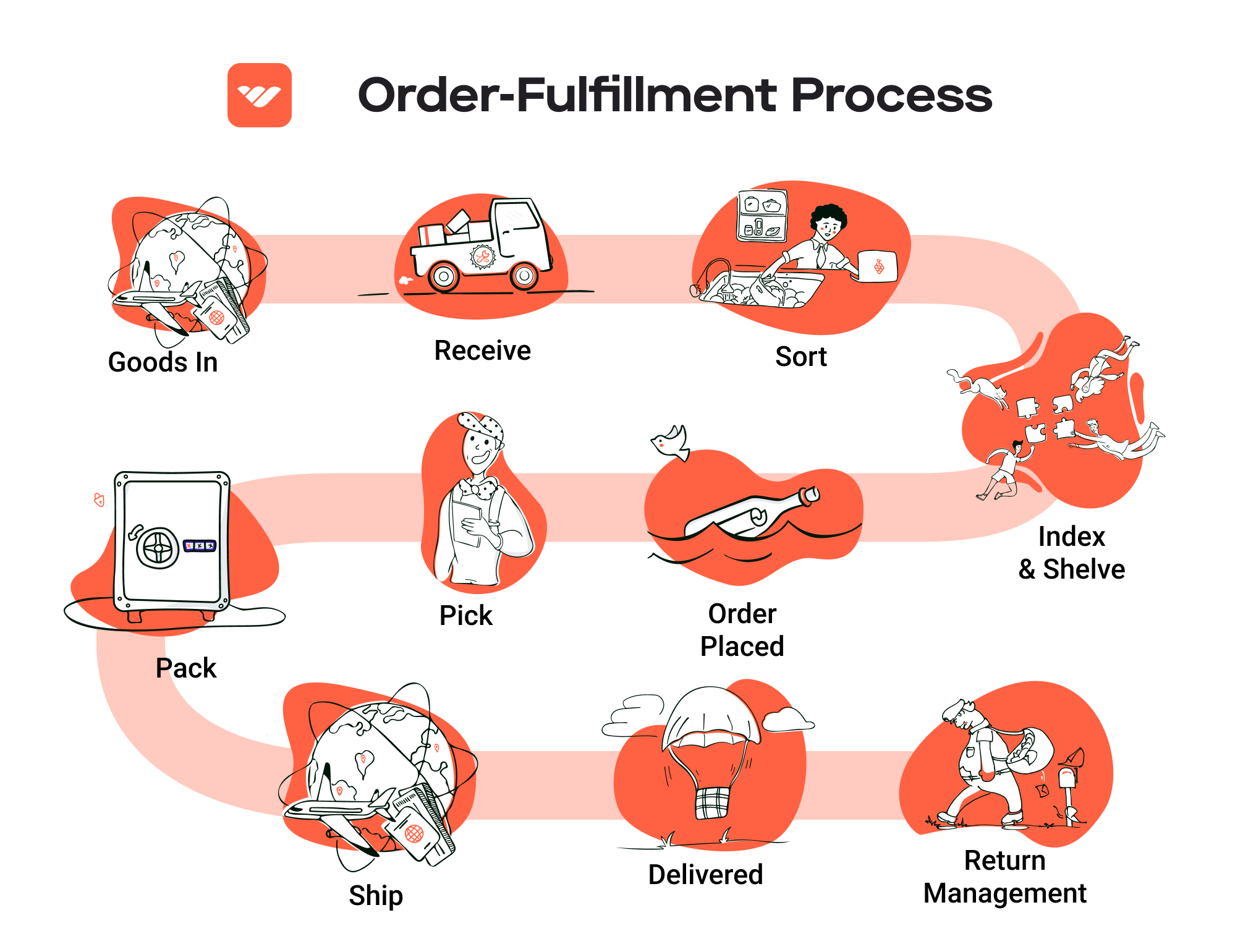
Pros of FBA
Prime Eligibility
One of the most significant advantages of using FBA is that products become eligible for Amazon Prime. This increases visibility and attracts more customers who prefer the fast and free shipping that Prime offers. As a result, sellers often see a boost in sales.
Customer Trust
Amazon has established a high level of trust with consumers. By using FBA, sellers can leverage this trust as their products are backed by Amazon’s customer service and return policies. Customers are more likely to purchase from FBA sellers because they are assured of reliable service.
Multi-Channel Fulfillment
FBA isn’t limited to just Amazon sales. Sellers can use FBA to fulfill orders from other sales channels, such as their own websites or other marketplaces. This allows for streamlined logistics and inventory management across multiple platforms.
Scalability
FBA allows sellers to scale their operations without the need to manage logistics themselves. As sales grow, sellers can easily send more inventory to Amazon without worrying about hiring additional staff or managing shipping logistics.
Access to Advanced Technology
By utilizing Amazon’s infrastructure, sellers gain access to advanced technology and resources. This includes inventory management systems, shipping logistics, and data analytics, which can help businesses make informed decisions.
Cons of FBA
High Fees
While FBA offers many advantages, it comes at a cost. Sellers incur various fees, including storage fees, fulfillment fees, and additional charges for long-term storage. These fees can add up, especially for slow-moving inventory, impacting profit margins.
Strict Inventory Rules
Amazon has stringent inventory management policies, including limits on how much inventory can be stored at its warehouses. Sellers must carefully plan their inventory levels to avoid overstocking or stockouts, which can lead to additional fees or lost sales.
Commingling Risks
FBA products can be commingled with inventory from other sellers, which can lead to issues if a product is defective or if there are quality concerns. If a customer returns a product, it may not be possible to determine which seller it originally came from, complicating returns and potential damage to a seller’s reputation.
Loss of Control
By outsourcing logistics to Amazon, sellers relinquish a certain degree of control over their inventory and shipping processes. This can be a concern for sellers who prefer to manage their own fulfillment.
Complex Return Process
While Amazon handles returns for FBA products, the process can be complex for sellers. Returned items may not always be in resalable condition, leading to potential losses. Additionally, understanding Amazon’s return policy is essential to mitigate risks.
Who is FBA Best For?
Fulfillment by Amazon is ideally suited for:
-
Small to Medium-Sized Businesses: Those looking to scale quickly without investing heavily in logistics and warehousing.
-
E-commerce Entrepreneurs: Individuals who want to focus on product sourcing and marketing while leaving fulfillment to Amazon.
-
Retailers with Seasonal Products: Sellers who experience peak sales during specific times of the year can benefit from Amazon’s ability to handle large volumes of orders efficiently.
-
Brands Seeking Global Reach: Businesses looking to tap into Amazon’s extensive customer base both domestically and internationally can leverage FBA to expand their market presence.
-
Sellers with High Turnover Rates: Those selling fast-moving consumer goods will find FBA beneficial for maintaining stock levels and ensuring quick delivery times.
In conclusion, FBA presents a powerful opportunity for e-commerce businesses to streamline operations and enhance customer satisfaction. However, it is crucial for sellers to weigh the pros and cons carefully and assess whether FBA aligns with their business goals and operational capabilities.
Core Services Offered by Fulfillment Centers
Inventory Management & Warehousing
Inventory management is the backbone of any successful e-commerce operation. Fulfillment centers provide comprehensive inventory management services, which include receiving, storing, and tracking products. This process begins when products arrive at the center, where they are checked for accuracy against purchase orders and subsequently stored in designated areas. Advanced inventory management systems track each item’s location and quantity, ensuring that e-commerce businesses have real-time visibility into their stock levels.
The benefits of effective inventory management are manifold. Firstly, it minimizes the risk of stockouts or overstock situations, both of which can lead to lost sales or increased holding costs. By maintaining optimal inventory levels, e-commerce businesses can respond more swiftly to customer demand, enhancing customer satisfaction and loyalty. Additionally, sophisticated warehousing solutions utilize space efficiently, allowing businesses to store a larger variety of products without incurring excessive overhead costs. This scalability is crucial for growing businesses that need to adapt to changing market conditions.
Pick and Pack Services
Pick and pack services involve the process of selecting items from inventory (picking) and then packaging them for shipment (packing). Fulfillment centers use sophisticated technology, including automated systems and trained personnel, to streamline this process. Orders are typically processed in batches, where items are picked based on order specifications and then packed into shipping boxes ready for dispatch.
This service provides significant advantages to e-commerce businesses. Firstly, it enhances order accuracy, as fulfillment centers often employ quality control measures during the packing process. This reduces the likelihood of returns and exchanges due to incorrect orders, which can be costly and time-consuming. Secondly, the speed at which orders are processed can significantly impact customer satisfaction. With efficient pick and pack services, e-commerce businesses can offer faster shipping times, a key factor in today’s competitive marketplace. Finally, outsourcing these services allows businesses to focus on core operations like marketing and product development, while leaving logistics to the experts.
Kitting and Assembly
Kitting and assembly services involve the grouping of individual products into a single package or kit, often requiring some level of assembly. This is particularly beneficial for e-commerce businesses that sell products requiring assembly or complementary items that are often purchased together. Fulfillment centers can handle the entire kitting process, from assembly to packaging and labeling.
The benefits of kitting and assembly are particularly notable for businesses looking to enhance their product offerings. By bundling products together, businesses can create appealing packages that encourage customers to purchase more items at once. This not only increases average order value but also simplifies the customer’s buying experience. Additionally, kitting services can reduce the time spent by customers on assembling products, which can lead to higher satisfaction rates. For businesses, this means reduced returns and an enhanced reputation for quality service.
Returns Management (Reverse Logistics)
Returns management, or reverse logistics, is the process of handling returned products efficiently. A fulfillment center’s returns management service includes receiving returned items, inspecting them, restocking them if they are in sellable condition, and processing refunds or exchanges. This service is crucial in e-commerce, where returns rates can be significantly higher than in traditional retail.
The benefits of effective returns management are substantial. Firstly, it enhances customer trust and satisfaction, as a straightforward returns process encourages more customers to make purchases, knowing they can easily return items if necessary. Secondly, efficient returns handling minimizes losses from returned inventory, as items can be quickly restocked and made available for resale, thus recouping potential losses. Lastly, fulfillment centers often analyze return data to provide insights into product performance and customer preferences, enabling e-commerce businesses to make informed decisions about product offerings and marketing strategies.
In summary, fulfillment centers provide a suite of core services that are essential for the efficient operation of e-commerce businesses. By leveraging services such as inventory management, pick and pack, kitting and assembly, and returns management, businesses can scale their operations effectively, enhance customer satisfaction, and ultimately drive growth.
How to Choose a Fulfillment Partner: A 6-Point Checklist
Location & Warehouse Network
Importance:
The geographic location of your fulfillment partner’s warehouses can significantly impact shipping times and costs. A strategically located fulfillment center reduces delivery time to customers, which is crucial for maintaining customer satisfaction and loyalty.
Questions to Ask:
– Where are your warehouses located, and how do they align with my target customer base?
– What is your shipping network like? Do you have multiple facilities to ensure coverage?
– How do you handle regional variations in shipping rates and delivery times?
Technology & Integrations
Importance:
In today’s fast-paced e-commerce environment, technology plays a vital role in streamlining operations. Your fulfillment partner should have robust systems for inventory management, order processing, and tracking shipments. Additionally, seamless integration with your e-commerce platform can improve operational efficiency.
Questions to Ask:
– What technology platforms do you use for inventory management and order processing?
– Can your systems integrate with my existing e-commerce software (e.g., Shopify, WooCommerce, etc.)?
– Do you offer real-time tracking for shipments, and how is this information communicated to customers?
Specializations (e.g., cold storage, oversized items)
Importance:
Different businesses have unique storage and handling needs. If you sell specialized products, such as perishables, hazardous materials, or oversized items, it is essential to choose a partner that can accommodate these requirements.
Questions to Ask:
– Do you have the capability to handle specialized items, such as cold storage or oversized products?
– What safety and compliance measures do you have in place for handling these types of goods?
– Can you provide case studies or references from similar businesses that you have worked with?
Scalability & Capacity
Importance:
As your business grows, so will your fulfillment needs. Choosing a partner that can scale operations to match your growth is crucial for long-term success. This includes having the capacity to handle increased order volumes during peak seasons without compromising service quality.
Questions to Ask:
– What is your current capacity, and how do you plan to scale to meet increasing demand?
– How do you handle seasonal fluctuations in order volume?
– Are there any limitations on the types of products or volumes you can manage as we grow?
Pricing and Contracts
Importance:
Understanding the pricing structure and contract terms is essential to avoid unexpected costs and ensure that you can maintain profitability. A transparent pricing model allows you to budget accurately and plan for the future.
Questions to Ask:
– What are your pricing structures (e.g., per order, per item, storage fees)?
– Are there any hidden fees I should be aware of, such as for returns or special handling?
– What are the terms of the contract? Is there flexibility for renegotiation as our needs change?
Customer Support & Reviews
Importance:
Reliable customer support can make or break your relationship with a fulfillment partner. Quick responses to inquiries and proactive problem-solving are essential for maintaining operational efficiency. Additionally, reviewing feedback from other businesses can provide insights into the partner’s reliability and service quality.
Questions to Ask:
– What levels of customer support do you offer? Is there a dedicated account manager?
– How do you handle issues or disputes that may arise during the fulfillment process?
– Can you provide references or testimonials from other clients, particularly those in my industry?
Conclusion
Choosing the right fulfillment partner is a critical decision that can impact your e-commerce business’s efficiency, customer satisfaction, and overall growth. By carefully considering these six key areas, you can ensure that your chosen partner aligns with your business goals and can support you as you scale. Make sure to conduct thorough due diligence, ask the right questions, and evaluate potential partners based on their ability to meet your unique needs.
Understanding Fulfillment Pricing: A Breakdown of Common Fees
Initial Setup Fees
When partnering with a fulfillment center, businesses often encounter initial setup fees. These fees cover the costs associated with establishing your account and integrating your systems with the fulfillment provider’s platform. The setup process may involve technical support, training, and the configuration of inventory management systems.
Typically, initial setup fees can range from a few hundred to several thousand dollars, depending on the complexity of your operations and the fulfillment center’s capabilities. Some providers may offer free setup as part of promotional packages, while others may charge a flat fee or a percentage of your projected sales volume. It’s essential to clarify what services are included in the setup fee to avoid unexpected costs later.
Receiving Fees
Receiving fees are charged when your inventory arrives at the fulfillment center. This fee compensates the center for unloading, inspecting, and storing your products. Generally, receiving fees are calculated based on the number of pallets or boxes received and can range from $20 to $50 per pallet.
Some fulfillment centers may have tiered pricing based on volume, offering lower rates as your shipments increase. Additionally, if your products require special handling, such as repackaging or labeling, these services may incur additional charges. Always inquire about the specifics of receiving fees to ensure you account for all potential costs.
Storage Fees (per pallet/bin)
Storage fees apply to the space your inventory occupies within the fulfillment center. These fees are usually calculated on a per-pallet or per-bin basis and can vary significantly based on the provider and the location of the warehouse. Typical storage fees range from $10 to $30 per pallet per month.
It’s important to understand that storage fees can fluctuate based on seasonal demand. For example, many fulfillment centers implement peak season pricing, increasing storage fees during high-demand periods such as holidays. To minimize storage costs, consider optimizing your inventory levels and utilizing just-in-time inventory strategies to align your stock with demand.
Pick & Pack Fees (per item/order)
Pick and pack fees are associated with the process of selecting items from storage and preparing them for shipment. These fees are typically charged per item or per order, depending on the fulfillment provider’s pricing structure. On average, pick and pack fees can range from $1 to $5 per item, with discounts available for bulk orders.
The complexity of your order can also influence pick and pack fees. For instance, if your orders frequently require custom packaging or special instructions, be prepared for higher fees. To control costs, streamline your product offerings and ensure that your orders are as efficient as possible.
Shipping Fees
Shipping fees encompass the costs incurred when your products are dispatched to customers. These fees can vary based on several factors, including the shipping method (standard, expedited, or same-day), the destination, and the weight and dimensions of the package. Fulfillment centers typically negotiate shipping rates with carriers, so the rates you receive may be lower than standard retail shipping rates.
Shipping fees can be structured in various ways, such as flat rates, weight-based pricing, or distance-based fees. It’s crucial to understand how your fulfillment center calculates these fees, as they can significantly impact your overall costs. Additionally, consider offering free shipping to customers by incorporating shipping costs into your product pricing, which can enhance customer satisfaction and increase conversion rates.
Tips for Getting an Accurate Quote
-
Detail Your Needs: Provide the fulfillment center with comprehensive information about your products, expected order volumes, and specific requirements. The more details you share, the more accurate the quote will be.
-
Request Itemized Pricing: Ask for a breakdown of all fees associated with your account, including setup, receiving, storage, pick and pack, and shipping fees. An itemized quote allows you to identify potential cost-saving areas.
-
Compare Multiple Providers: Don’t settle for the first quote you receive. Compare pricing from several fulfillment centers to ensure you’re getting a competitive rate.
-
Inquire About Discounts: Many fulfillment providers offer volume-based discounts or promotional rates for new clients. Be sure to ask about any available savings.
-
Consider Long-Term Contracts: If you anticipate a long-term partnership, discuss contract options that may yield better pricing and terms over time.
By understanding these common fulfillment pricing models and leveraging strategic tips, you can better navigate the complexities of fulfillment costs and optimize your e-commerce operations for growth.
Frequently Asked Questions (FAQs) about Fulfillment
1. What is the Canton Amazon Fulfillment Center (JAN1)?
The Canton Amazon Fulfillment Center, designated as JAN1, is a state-of-the-art, 3 million square foot facility located in Madison County, Mississippi. Officially opened in August 2022, it serves as a robotic sorting center capable of processing large volumes of orders efficiently. The facility employs advanced automation technology, including over 4,700 Kiva robots, to streamline operations like receiving, stowing, picking, and packing products.
2. How does the fulfillment process work at the Canton center?
At the JAN1 facility, the fulfillment process begins with receiving products, which are then stowed in designated locations. When an order is placed, the system identifies the product’s location, and Kiva robots retrieve the items, transporting them to human operators who pick and pack them. Once packaged, the boxes are sent to a sorting facility before being dispatched to delivery vehicles for final delivery to customers.
3. What types of products are handled at the Canton fulfillment center?
The Canton fulfillment center primarily processes non-sortable items, which include bulky or large products such as patio furniture, rugs, and other household goods. This specialization allows Amazon to efficiently manage the logistics of heavier items that require more space and care during handling.
4. What is the difference between a warehouse and a fulfillment center?
A warehouse is primarily used for storage, while a fulfillment center is designed for order processing and shipping. Fulfillment centers are equipped with advanced technology to handle inventory management, order picking, packing, and shipping, thereby focusing on delivering products directly to customers efficiently.
5. What are the benefits of using a fulfillment center for my e-commerce business?
Utilizing a fulfillment center like the Canton Amazon facility allows e-commerce businesses to streamline logistics, reduce shipping times, and enhance customer satisfaction. It provides access to advanced technology, experienced staff, and scalable operations that can adapt to seasonal demand fluctuations, freeing up resources for businesses to focus on growth and marketing.
6. What is a 3PL (Third-Party Logistics)?
A 3PL is a service provider that manages logistics and supply chain operations for businesses. This includes warehousing, order fulfillment, transportation, and distribution. Partnering with a 3PL allows e-commerce businesses to outsource logistics operations, reducing overhead costs and improving operational efficiency.
7. How much do fulfillment services cost?
Fulfillment service costs can vary based on several factors, including the volume of orders, the type of products being stored and shipped, and the specific services provided (e.g., picking, packing, shipping). Generally, fees may include storage fees (per cubic foot), order processing fees (per order), and shipping fees (based on weight and destination). It’s essential to evaluate your business’s unique needs and compare pricing structures from different fulfillment providers to find the best fit.
8. What employment opportunities are available at the Canton fulfillment center?
The Canton fulfillment center offers various employment opportunities, including roles in operations, management, robotics, and logistics. Initially employing about 700 people, the facility has the potential to create up to 1,500 jobs as it scales. Positions often require training for operating automated systems and can lead to high-skill job opportunities.
9. How does Amazon ensure the safety of its workers at the Canton facility?
Safety is a top priority at the Canton fulfillment center. The facility is equipped with designated shelter areas for emergencies, such as severe weather, and features wellness zones for employee health. Additionally, Amazon provides comprehensive training and adheres to strict safety protocols to ensure the well-being of its associates.
10. What role does automation play in the Canton fulfillment center?
Automation is integral to the operations at the Canton fulfillment center, with over 4,700 Kiva robots enhancing efficiency in the picking and packing processes. These automated systems allow for higher volume processing than traditional warehouses, while human workers are still essential for oversight, quality control, and handling exceptions. This combination of automation and human expertise helps improve operational efficiency and reduces order fulfillment times.
Conclusion: Is Outsourcing Fulfillment the Right Move for Your Business?
Evaluating the Benefits of Outsourcing Fulfillment
Outsourcing fulfillment can be a transformative strategy for e-commerce businesses looking to scale efficiently. By leveraging a fulfillment service, you can save significant time and resources that would otherwise be spent managing logistics. This allows you to concentrate on core business activities such as marketing, product development, and customer service, ultimately driving growth.
One of the primary advantages of utilizing a fulfillment partner is scalability. As your business grows, your fulfillment needs will change. A dedicated fulfillment service can easily adjust to fluctuations in order volume, seasonal demands, and product diversity without requiring you to invest in additional infrastructure or staff. This flexibility ensures that you can meet customer expectations consistently, which is critical in today’s competitive landscape.
Moreover, fulfillment centers often bring specialized expertise in logistics management, inventory control, and shipping optimization. By partnering with professionals who understand the intricacies of supply chain management, you can tap into best practices and advanced technologies that improve operational efficiency and reduce costs. For instance, facilities equipped with automation, like Amazon’s new centers, can process orders faster and with greater accuracy, enhancing customer satisfaction.
However, it’s crucial to choose the right fulfillment partner to support your business’s growth. Conduct thorough research to identify providers that align with your operational needs, budget, and customer service standards.
Call to Action
Now is the perfect time to evaluate your current shipping and fulfillment processes. Consider conducting an audit to identify inefficiencies or areas for improvement. Ask yourself: Are you equipped to handle increased demand? Is your current process scalable? By assessing these questions, you can determine if partnering with a fulfillment service is the strategic next step for your business. Make informed decisions that pave the way for sustainable growth and success in the e-commerce marketplace.
Important Disclaimer
⚠️ Important Disclaimer
The information in this guide is for educational purposes. Fulfillment services, pricing, and platform features change frequently. Always conduct your own due diligence and consult with providers directly before making business decisions.
